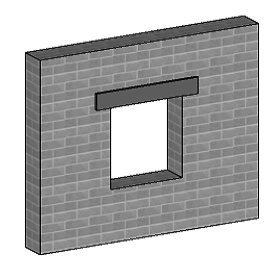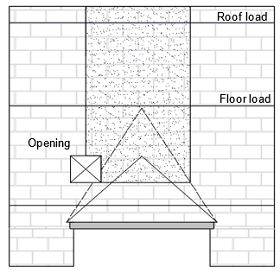> >
Lintel Analysis
|
|
Download Sample Report |
The scope of this calculation module is to analyse a lintel beam subjected to masonry loads. Additionally, roof, floor and point loads can be specified as optional. Maximum bending moment and total equivalent load on the beam is calculated with or without openings in the masonry wall. The masonry wall can be either solid or cavity type with or without insulation.
Available Standards: British
Features
- The module allows various masonry types to model the masonry wall for analysis such as,
- Wall type
- Solid
- Cavity (without insulation)
- Insulation (cavity wall with insulation)
- Openings: In this option user can specify up to two openings.
- Loads: Includes floor load, roof load and point load.
- Floor load: Floor load can be added to structure for two levels on two sides of the beam.
- Roof load: Roof load can be added to structure on two sides of the beam.
- Point load: A maximum of three-point loads can be added to the structure.
- The module calculates an equivalent uniformly distributed loads (total equivalent load as per provisions of Appendix A of BS 5977 - 1: 1981).
Design Considerations
- Self-weight of the lintel beam shall be specified by the user.
- All the masonry within the load triangle is taken as a load on the lintel as per BS 5977 - 1: 1981.
- Openings should not be located partially in the load zone, nor fully within the interaction zone. There can only be a maximum of two openings in a row.
- Floor and roof loads cannot pass through the openings in the masonry wall.
- Point loads cannot be located within the openings.
- Design load factors for live and dead loads shall be specified for the calculation of maximum design moment and shear force in the beam.
- Horizontal effect of wind load is not considered in analysis.
- As per BS 5977 - 1: 1981, if the bottom level of the opening is located below the height of the interaction zone and interacts with it, it is assumed that the additional loading is considered and distributed over the span of lintel.
- Loads are dispersed at 45° and carried by the lintel for any point load or distributed load applied to the masonry.
- When openings are available in interaction zone, additional masonry area (additional area of masonry above the level of interaction) is calculated depending upon the number of opening and the interaction of opening with the zone of the other opening.
- If the opening interacts with the interaction zone above the level of load zone the additional masonry area load is reduced to 50% and distributed over the lintel.
- If the floor or roof load interacts with both load zone and interaction zone the portion of load occurring in the interaction zone length is reduced by 50% whereas the load occurring on the load zone is fully distributed over the span of lintel. Both portion of loads are dispersed at an angle 45° from the level of interaction.
- Point load occurring in the load zone and interaction zone is distributed in the similar way as carried out for floor or roof load.
- If the opening interacts with the interaction zone below the level of load zone, load having load application length occurring at the load zone is dispersed at an angle 45° and distributed over lintel span. Load having the load application length occurring at the interaction zone is reduced to 50% and dispersed at an angle 45°.
- All loads interacting with additional masonry area zone (when opening is available) are distributed over the lintel span depending upon the level at which the opening is interacting. If the opening interacts with the interaction zone at a level above the load zone the loads are reduced to 50%, dispersed at an angle 45°.
- Total equivalent load on beam is the sum of loads due to openings, floors, roofs, and point loads.
National Standards Available
British Standard
References
- BS 5977-1:1981 - Lintels - Part 1: Method for assessment of load.
Revision
- Ver 1.0 - Original version
|
|
Download Sample Report |


